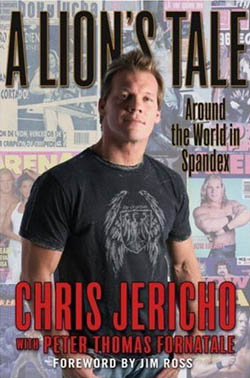On the back of Chris Jericho’s A Lion’s Tale: Around The World In Spandex, Mick Foley writes about how much he enjoyed reading the book. “Suddenly, all that enjoyment stopped and a wave of momentary panic crashed right into my literary ego. ‘Oh no,’ I thought. ‘What if this book is better than mine?'” With all due respect to Mick, he may just be right.

Starting with Jericho’s youth growing up in Winnipeg as the son of former NHL hockey player Ted Irvine, and closing with his WWF debut, the book is broken up into ten parts. “Winnipeg” focuses on Jericho’s initial love of the business and his youth. “Calgary” brings Jericho to his training at the Hart Brothers camp in Okotoks. Part three, “Wichita and Elsewhere” speaks of his early days in the business and traveling around for virtually nothing, being paid in hot dogs and glasses of orange juice.
It is from part four onward that Jericho fans will start to recognize parts of his career that they have followed. “Mexico” takes Jericho south of the border, where he narrowly escaped being called He-Man and takes on the name Leon D’Oro (Golden Lion) that would later morph into the Lionheart nickname that he carried on for a large chunk of his career. It is in this chapter that Jericho discusses some initial problems with fellow Canadian Vampiro, as well as the early days of his relationship with Eddy Guerrero and Art Barr.
From Mexico it is on to part five, “Germany” about Jericho working a tournament in a tent and meeting Fit Finlay for the first time. It is then on to “Knoxville” which covers his time with Lance Storm as The Thrillseekers in Smokey Mountain Wrestling. The chapter details the infamous angle where Jericho was bloodied heavily by The Heavenly Bodies. The section also contains stories about the always entertaining Jim Cornette, including the fact that it was Jericho who videotaped Cornette’s infamous profanity-laced tirade at a Dairy Queen.”Japan” is where Chris Jericho really burst onto the wrestling world’s consciousness with his Super J Cup tournament match against Chris Benoit in 1995. It took awhile to get to that match, and Jericho’s brief time in FMW and extensive tours with WAR, including his classics with Ultimo Dragon and later in the book his horrendous one night run as “Super Liger” are touched upon.
“Philadelphia” is where Chris Jericho became extreme. While Jericho’s time in ECW was brief, it was memorable. While only 14 pages long, the section provides an interesting look into Jericho’s time there, his TV title run, and dealing with Paul Heyman.
“Atlanta” provides a similar look at WCW as many other DVDs and books. Jericho writes that he was doomed from the start when meeting Eric Bischoff to discuss and sign a contract he asked “so who’s the third member (of the upcoming start of the NOW angle) going to be?” Initially saddled with a generic babyface gimmick, the section covers the struggles he had to be noticed amidst a huge roster, his heel turn, classic feud with Dean Malenko, and all of the political strife that came with working in WCW during the late 1990s. Proof of this comes in statements like Terry Taylor coming to Jericho the night before his Halloween Havoc 97 and telling him he would lose to Japanese wrestler Gedo, stating, “Well at least you’ll be on the show. The boss can take a look at you and see what you can do.” Jericho had been with the company for over a year.
Also of interest is Jericho’s “feud” with Goldberg towards the end of his run. Jericho speaks about lobbying and pushing a feud that made sense, still put over Goldberg, but gave the fans what they wanted. After a tremendous build up, the feud was dropped and Jericho was in a meaningless feud with Bobby Duncum Jr. It was the beginning of the end as Jericho made plans to leave WCW. The disorganization WCW was legendary for comes shining through as Jericho had agreed verbally to a new contract, but never actually received it.The book wraps with “New York, New York.” In it Jericho speaks about the death of Owen Hart, who he one day hoped to be tag team champions in the WWF with. After talking about preparing for his first promo, including his handwritten notes, the book ends with the countdown to his 1999 debut and verbal joust with The Rock, leaving the door wide open for a sequel.
Jericho’s personality is a major selling point for the book. While it is co-authored by Peter Thomas Fornatale, it is Jericho’s voice that comes out of the pages. His unique sense of humour results in many legitimate laugh out loud moments (and a few funny looks from people around you). Early in the book he discusses his youth spent trying to get wrestlers autographs when they would come to Winnipeg, and some of the responses he got from ’80s stars like Koko B. Ware, Sika and The Dynamite Kid are pretty amusing. The book is also filled with pictures throughout Jericho’s career.
Aside from many of the jokes, the heart of the story is honest and emotional. A consistent thread throughout the book is the loss of Jericho’s brothers, starting with Art Barr and moving forward through far to many. Also touched upon is the tragedy that left Jericho’s mother paralyzed, his parents divorce, and a brief look at the start of his relationship to his wife, Jessica.
Jericho does tell some interesting tales that may surprise people. The fact that none of the Hart Brothers really had anything to do with his training despite the camp being in their name certainly clears up some misconceptions about Jericho’s career. His interactions with people like Hulk Hogan, Eric Bischoff, Jim Cornette, and many others adds Jericho’s own insight to the stories of their lives. If there is one flaw in the book, it is that Jericho at times flows from one story to another without getting any details. Having interviewed so many wrestlers and listened to their stories, I could spend hours listening to them speak. Trying to cram nine years into 411 pages is a daunting task for certain, and left me wishing I had more.
Canadian wrestling fans will see a few familiar names within these pages as well. There are many amusing stories about Lance Storm, from their early days where Lance was a better student than Chris to their days in Smokey Mountain Wrestling. Bret Como (The Black Dragon), Lenny St. Clair (Dr. Luther), Rick Bognar (Big Titan), and Mike Lozanski all get mentioned many times throughout the book.Chris Benoit is also a major influence throughout the book, as he was on Jericho’s career. The book was complete and ready to go to press when June’s murder-suicide happened. Jericho includes a note at the beginning of the story that the man in the book is not the one from his final days of life. Inside the book is a photo of Jericho, Stu Hart and Chris and Nancy Benoit at the funeral of Owen Hart. Under it Jericho writes, “I debated for weeks whether or not to include this picture and I changed my mind a dozen times. In the end, I felt that to pull this picture would suggest that Chris and Nancy never existed. But they did exist and they loved each other and I loved them. So it stayed.”
Jericho’s story is that of one of the last men to go through the “old school” style of breaking into the business — working small independents and territories, working into international markets, and then going through the “big three” of ECW, the WCW, and the WWF. Longtime fans of Jericho’s will find new insight into his career and thoroughly enjoy this book. People who have only watched him since the birth of Y2J in the WWF will enjoy reading about his history. And everyone will close the book and wait with anticipation in hopes of reading the next chapter of his life story. Anyone who is a wrestling fan should have a copy of A Lions Tale: Around The World In Spandex in their home library. It’s a book you’ll revisit again and again.
RELATED LINKS

